Posture!
Why is it sooo important?
Poor posture is an energy sapper. If your spine is incorrectly balanced, your muscles need to work harder to keep your body upright all day long. Lazy posture also causes your upright structure to collapse in places, like a poorly constructed building. In turn, this can compound many physical ailments, such as digestive problems, poor circulation, chronic low energy, lower back pain, headaches, and shortness of breath. (2) Often those nasty “stress” headaches you get are almost always a result of slouching over, tension in your traps from shrugging your shoulders during computer work, for example. This is all related to poor posture.
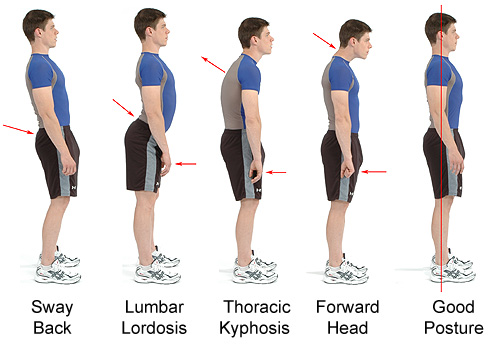
Do you have Good Curves?
The natural state of your back has three curves, which form an S, plus a final curve that forms the sacrum. We want to make sure that our bodies are aligned along these curves.
1. The first curve of your spine is the cervical (neck) curve. Consisting of seven small, flexible vertebrae that support your skull and the cervical curve tilts slightly forward (or anterior). Inflexibility and strain here is a common cause for neck tension and headaches. Probably one of the most common postural distortions is the Forward Head, forward rounded shoulders posture. This postural problem often appears in teenagers and progresses to old age. (3)
2. The second curve of your spine is the thoracic (mid back) curve. This curve has 12 vertebrae, which are larger and more rigid than the cervical vertebrae, but still flexible. The thoracic curve has a prominent backward (or posterior) curvature.
3. The third curve of your spine is the lumbar (low back) curve. This curve consists of five massive vertebrae that carry most of the weight of your body. The lumbar curve has a flexible forward (or anterior) tilt. This area is probably one of the most common for “lower back pain.” Loaded flexion movements like incorrect heavy lifting during a deadlift or rounding the lower back during your squats can exacerbate this pain. Ever wonder why your lower back hurts after a day of deadlifts or squats?
4. A final, fixed posterior curve is the 5 fused bones of the sacrum, where the spine attaches to the pelvis. Micro movements in the sacral area can often cause nerve impingement with severe pain. The sharp shooting pain down your leg often originates from around this area.
To keep your spine well-aligned and healthy, you must maintain the balance of these curves. By maintaining this alignment you minimize stress on the spine, which helps prevent back pain and injury.
If your posture is good, as illustrated here, these spinal curves lend shock absorption, extra flexibility, and range of motion to your movement. Having evenly developed back muscles and strong abs helps support the spine. But if there is too much or too little curve in your spine, or if the curves do not balance properly with one another, your posture is poor, which can lead to structural problems and back pain.

From a normal curved Spine posture to a bad curved spine posture:
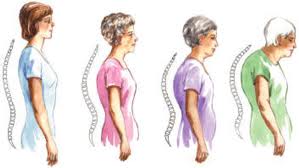
Forward Head Posture
An anterior positioning of the cervical spine is characteristic of forward head posture, or protracted neck. Forward head posture may make it more difficult to perform exercises with the bar in front of head or neck. Evaluate neck position at night since elevating head too high with additional pillows may act as a continuous neck stretch throughout the evening exacerbating the forward head posture.
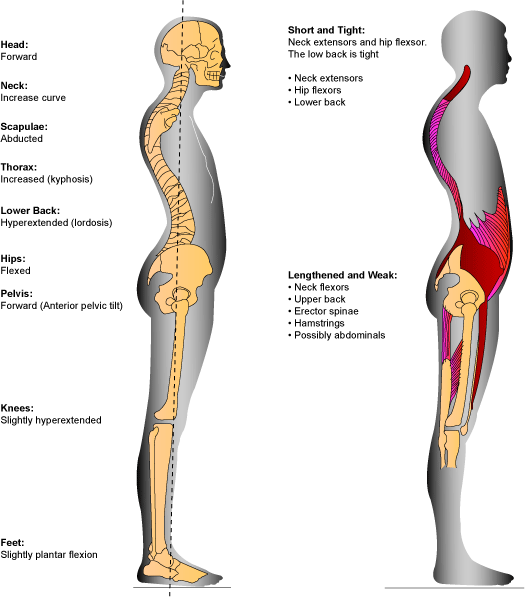
Sitting with poor posture!
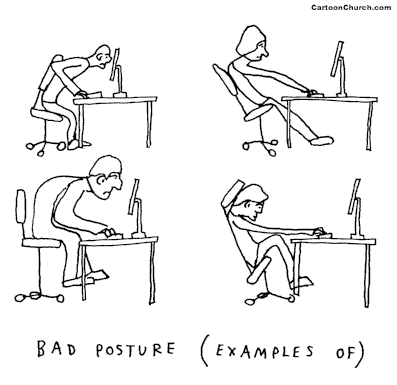
Sitting with poor posture can lead to yield negative effects on the body by placing stress on the back, joints and tendons. It leads to improper body alignment, which can can cause muscular imbalances. It is important to identify and correct poor posture in order to prevent long-term effects.
Intervertebral Disc Damage
Intervertebral discs are located between the vertebrae, they cushion the spine and serve as shock absorbers. Poor posture places stress on the discs which result in or protrusion which press against the nerves and spinal cord. This can lead to pain and muscle soreness in other areas of the body.
Spinal Curvature
Spinal curvature can result from poor posture, which leads to further neck pain, headache and back pain. This curvature places pressure on the spine, decreasing its natural ability to absorb shock, making the back susceptible to further injury.
Bone Spurs
Bone spurs appear along the edges of the bones. They can rub against nerves, tendons or other bones, which can be quite painful. Treatment is available, though bone spurs may require surgery.
Lordosis
Pelvis is positioned forward and downward. Hips are slightly flexed and lumbar spine is excessively hyperextended. Hip flexors, erector spinae are short. Abdominal, hamstrings, gluteus maximus muscles may be weak. Increased risk of lower back injury during standing or lying hip extension, flexion, or stabilization activities, and weighted overhead activities. Seeabdominal weakness and hip flexor inflexibility.
- Examples of affected exercises:
- Squat
- Hack Squat
- Military Press (standing)
- Roman Chair Sit-up
- Example preventative / corrective exercises:
- Hip Flexor: Kneeling Hip Flexor Stretch
- Erector Spinae: Lower Back Stretch
- Abdominal: Crunches
- Hamstrings: Leg Curl
- Gluteus: Seated Leg Press
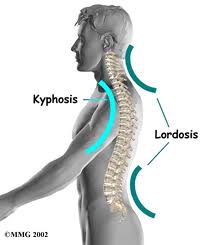
Kyphosis
Exaggerated anterior-posterior curvature of the vertebral column, most often involves an excessive forward bending in the thoracic area. Kyphosis occurs in older adults, particularly women with osteoporosis and osteoarthritis. Kyphosis is sometime accompanied with other posterior problems such as posterior or anterior pelvic tilt (compensates for altered line of gravity) and protracted shoulder girdle (unrelated). Kyphosis makes it difficult to include overhead exercises particularly when combined with a winged scapula condition or shoulder external rotation inflexibility.
- Examples of affected exercises:
- Shoulder Press
- Seated Triceps Extension
- Front Squat
- ww.exr x.net/WeightExercises/OlympicLifts/OverheadSquat.html">Overhead Squat
- Corrective exercises for gravity induced kyphosis: Strengthening of thoracic vertebral column extensors
- Stretching of thoracic vertebral column flexors
Kyphosis


